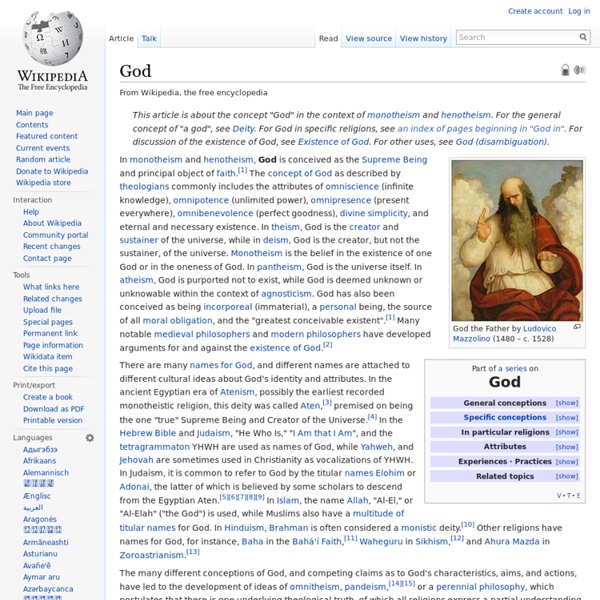Indonesia
Country in Southeast Asia Coordinates: 5°S 120°E / 5°S 120°E / -5; 120 Indonesia ( IN-də-NEE-zhə, -NEE-zee-ə; Indonesian: [ɪndoˈnesia]), officially the Republic of Indonesia (Indonesian: Republik Indonesia [reˈpublik ɪndoˈnesia]),[a] is a country in Southeast Asia, between the Indian and Pacific oceans.
Shangrala's God's Paintings!
GOD'S PAINTINGS! When God paints, we can all stand back and take notice of His greatness! Here are some pictures of His "Work In Progress".
Ontology
Study of the nature of being, becoming, existence or reality, as well as the basic categories of being and their relations Parmenides was among the first to propose an ontological characterization of the fundamental nature of reality. Etymology[edit] While the etymology is Greek, the oldest extant record of the word itself, the New Latin form ontologia, appeared in 1606 in the work Ogdoas Scholastica by Jacob Lorhard (Lorhardus) and in 1613 in the Lexicon philosophicum by Rudolf Göckel (Goclenius). The first occurrence in English of ontology as recorded by the OED (Oxford English Dictionary, online edition, 2008) came in a work by Gideon Harvey (1636/7–1702): Archelogia philosophica nova; or, New principles of Philosophy. Leibniz is the only one of the great philosophers of the 17th century to have used the term ontology.[6]
Java
island of Indonesia Java (Indonesian: Jawa; Javanese: ꦗꦮ; Sundanese: ᮏᮝ) is an island of Indonesia, bordered by the Indian Ocean on the south and the Java Sea on the north. With a population of over 141 million (Java only) or 145 million (including the inhabitants of its surrounding islands), Java has 56.7 percent of the Indonesian population and is the world's most populous island.[1] The Indonesian capital city, Jakarta, is located on its northwestern coast.
Universe
all of space and time and their contents The Universe is all of space and time[a] and their contents,[10] including planets, stars, galaxies, and all other forms of matter and energy. While the spatial size of the entire Universe is still unknown,[3] it is possible to measure the observable universe.
Kakawin Bhāratayuddha
First page of Gunning's kakawin Bhāratayuddha (1903) in Javanese characters. The poem was started by Sedah in 1157, and finished by Panuluh. Panuluh also wrote the Kakawin Hariwangsa.[1]:168 Kakawin Bhāratayuddha is an Old Javanese poetical rendering of some books (parva) of the Mahabharata by Mpu Sedah and his brother Mpu Panuluh in Indian meters (kāvya or Kakawin). The commencement of this work was exactly 6 November 1157.
The All
The universe understood in relation to the All[edit] The following is commentary on possibilities about The All but not anything necessarily accepted by Hermeticists in general. According to The Kybalion, The All is a bit more complicated than simply being the sum total of the universe. Rather than The All being simply the physical universe, it is more correct to say that everything in the universe is within the mind of The All, since the ALL can be looked at as Mind itself.[3] In effect, the universe is partially existent on the Mental plane, and we may in fact all be parts of The All's psychological makeup, representing parts of The All in its dream or meditation.
Dharmawangsa
Dharmawangsa (also spelled Dharmavamsa), stylized regnal name Sri Maharaja Isyana Dharmawangsa Teguh Anantawikramottunggadewa of Isyana dynasty was the last raja of the Kingdom of Medang reigned from 990-1016 CE. He also known in his posthumous name Wijayamreta Wardhana which means "powerful in glorious death", which refer to his fight to the death. Reign[edit] He succeeded Sri Makutawangsa Wardhana.
Anaxagoras
1. Life and Work Anaxagoras, son of Hegesibulus (or Eubulus), was a native of Clazomenae, on the west coast of what is now Turkey.
Wayang wong
Wayang wong, also known as wayang orang (literally "human wayang"), is a type of classical Javanese dance theatrical performance with themes taken from episodes of the Ramayana or Mahabharata. Performances are stylised, reflecting Javanese court culture: Despite being closely associated with Javanese tradition, variants of wayang wong dance drama can also be found in neighboring ethnic traditions, including in Balinese and Sundanese traditions. History[edit] The bas relief panels on the 9th-century Prambanan temple show episodes of the Ramayana epic.
Hermeticism
Not to be confused with Hermit. Hermeticism, also called Hermetism,[1][2] is a religious and philosophical/esoteric tradition based primarily upon writings attributed to Hermes Trismegistus ("Thrice Great").[3] These writings have greatly influenced the Western esoteric tradition and were considered to be of great importance during both the Renaissance[4] and the Reformation.[5] The tradition claims descent from a prisca theologia, a doctrine that affirms the existence of a single, true theology that is present in all religions and that was given by God to man in antiquity.[6][7] Many Christian writers, including Lactantius, Augustine,[8] Thomas Aquinas[citation needed], Marsilio Ficino, Giovanni Pico della Mirandola, Giordano Bruno, Campanella, Sir Thomas Browne, and Emerson, considered Hermes Trismegistus to be a wise pagan prophet who foresaw the coming of Christianity.[9][10] History[edit] Late Antiquity[edit]



